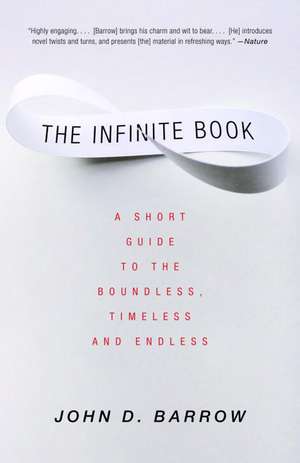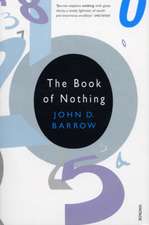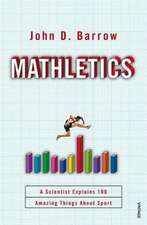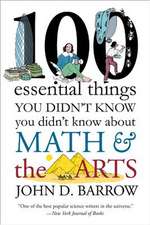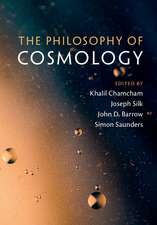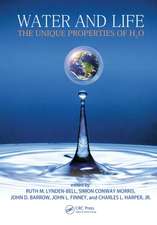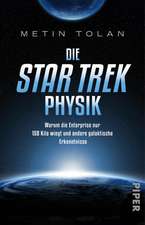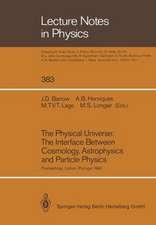The Infinite Book: A Short Guide to the Boundless, Timeless and Endless
Autor John D. Barrowen Limba Engleză Paperback – 31 aug 2006
Now Infinity is the darling of cutting edge research, the measuring stick used by physicists, cosmologists, and mathematicians to determine the accuracy of their theories. From the paradox of Zeno’s arrow to string theory, Cambridge professor John Barrow takes us on a grand tour of this most elusive of ideas and describes with clarifying subtlety how this subject has shaped, and continues to shape, our very sense of the world in which we live. The Infinite Book is a thoroughly entertaining and completely accessible account of the biggest subject of them all–infinity.
| Toate formatele și edițiile | Preț | Express |
|---|---|---|
| Paperback (2) | 69.06 lei 24-35 zile | +24.70 lei 4-10 zile |
| Vintage Publishing – 2 noi 2005 | 69.06 lei 24-35 zile | +24.70 lei 4-10 zile |
| Vintage Books USA – 31 aug 2006 | 131.01 lei 3-5 săpt. |
Preț: 131.01 lei
Nou
Puncte Express: 197
Preț estimativ în valută:
25.07€ • 25.90$ • 20.87£
25.07€ • 25.90$ • 20.87£
Carte disponibilă
Livrare economică 04-18 martie
Preluare comenzi: 021 569.72.76
Specificații
ISBN-13: 9781400032242
ISBN-10: 1400032245
Pagini: 328
Ilustrații: ILLUSTRATIONS THROUGHOUT
Dimensiuni: 143 x 185 x 19 mm
Greutate: 0.32 kg
Editura: Vintage Books USA
ISBN-10: 1400032245
Pagini: 328
Ilustrații: ILLUSTRATIONS THROUGHOUT
Dimensiuni: 143 x 185 x 19 mm
Greutate: 0.32 kg
Editura: Vintage Books USA
Notă biografică
John D. Barrow is Research Professor of Mathematical Sciences at the University of Cambridge. He is the author of several bestselling books, including Theories of Everything and Impossibility.
Extras
chapter one
Much Ado about Everything
‘On a clear day you can see forever.’
–Alan Lerner
THE ROUGH GUIDE TO INFINITY
‘If there is a Universal and Supreme Conscience I am an idea in it. After I have died God will go on remembering me, and to be remembered by God, to have my consciousness sustained by the Supreme Conscience, is not that, perhaps, to be immortal?
– Miguel de Unamuno
There is something about infinity and books. Never-ending stories, libraries that contain all possible books, books that contain everything that has ever happened, and everything that hasn’t; books that write themselves, books about themselves, books about there being no books, and books that end before they’ve begun. So you should be no more surprised to find yourself reading a book about infinity than I am to be writing one. But for something that you can’t buy on the internet, ‘infinity’ is strangely ubiquitous. It turns up in church sermons, mathematics lectures at all the best universities, popular science books about ‘Life, the Universe and Everything’, and mysticism the world over, while historians remind us that people have been burnt at the stake for talking about it. It is at once the staple of the mystic contemplation of reality – ‘make me one with everything’ as the mystic said to the hamburger vendor – and the familiar territory of science fiction and fantasy. Can all these things really be connected? Is infinity really that big?
For thousands of years in the West there was no more seditious idea on Earth than that of infinity. The idea that things might go on and on forever, that they need have neither beginning nor end, neither centre nor boundary, was contrary to the wisdom of the West. It threatened to displace God Almighty from His uniquely infinite status, to demote the Earth from the centre of the Universe, and destroy the uniqueness and special meaning of every event in creation. It had the potential to make what was once merely the possible become inevitable.
Yet the temptation to think that way was strong and simple. Once you start doing something over and over again it’s not too hard to imagine what it would be like never to stop. Infinity is just one thing after another. And this tantalising mixture of simplicity and sophistication remains with us today. Infinity is a subtle idea to capture precisely and easy to throw into the dustbin of wishful thinking, but for the ordinary person in the street it is less surprising and more readily intelligible than any comparable abstraction. We are immune to its subtleties; protected by a strange familiarity inbred by religious traditions, or from just staring out at the dark night sky; convinced by our method of counting that there could never be a biggest number. If in doubt just add one. Or can you?
Yet infinity remains a fascinating subject. It lies at the heart of all sorts of fundamental human questions. Can you live forever? Will the Universe have an end? Did it have a beginning? Does the Universe have an ‘edge’ or is it simply unbounded in size? Although it is easy to think about lists of numbers or sequences of clock ‘ticks’ that go on forever, there are other sorts of infinity that seem to be more challenging. What about an infinite temperature or an infinite brightness – can such physical things actually be infinite? Or is infinity just a shorthand for ‘finite but awfully big’? These sorts of infinity seem more problematic than the unending futures promised to the followers of many traditional religious faiths. Eternal life doesn’t need anything infinite to happen here and now. It just means that there will always be something happening – always a there and then.
The other religiously motivated infinity is that which goes loosely with the idea of a God of limitless power and knowledge, which is a key ingredient of many Western religious traditions. This is another familiar touchstone for the concept of the infinite for everyone. You don’t need to be a mathematician to feel that this type of transcendental infinity is familiar. Or do you?
You do need to be something of a mathematician to appreciate the other type of infinity. Numbers go on and on. Infinity seems to be nothing more than where they would get to if counting went on forever. But surely it never does and mathematical infinity looks like a promise that is never fulfilled, a numerical Peter Pan, a shorthand for a goal that is never reached, a potential but not an actual, a number bigger than all numbers. Or is it?
Already we begin to sense that there are different sorts of infinity and you might believe in one but not another. In this book we are going to explore these infinities from different directions. We will see how human thinking came to embrace the idea of the infinite before recoiling from its implications. We will see how the argument raged about whether any true infinity ever materialised in our finite Universe; or whether infinities were artefacts of an inadequate description of events, are invariably relegated to happen in the infinite future, or are excluded from reality by a hidden principle that upholds the logical consistency of the Universe. We will find that eventually mathematicians became accustomed to dealing with infinities as if they were real entities, adding and subtracting them, cataloguing all the different infinities, determining their sizes, and finding that some were bigger than others – infinitely bigger. But we will mingle our story with tales that make the paradoxes of the infinite grow to become as large as life.
INTIMATIONS OF THE INFINITE
‘think globally but act locally’
Activist bumper sticker’
We know where the famous ‘lazy eight’ • symbol for infinity came from. The Oxford mathematician John Wallis, who was famous for writing the codes for both sides in the English Civil War, first wrote down the symbol in 1655. With a few strokes of his pen he adapted the Roman representation |… sometimes used instead of M for the (for them, large) number 1000. When written quickly it became • and it stuck. This and other uses of this evocative symbol can be seen in Figure 1.1.
Where did the idea of infinity come from? Does it bring with it some subtle survival value that favoured those with the inclination to develop it? Evolutionary psychologists would look for some way of thinking or acting which aided survival on African savannah landscapes a million years ago and had as a by-product the liking for generalisation without end. Nothing specific is immediately obvious. Primitive life was brief and immediate. Action was needed. Contemplation was not rewarded. The inclination to think about infinity is something that happens much later in the human story and it emerges from one of many responses to the Universe around us. What are the trails that might lead to forever?
There is a single pattern to many of the intuitions that have led human minds to contemplate the infinite. Human consciousness enables us to look ahead and see patterns. This enables us to compress experience into formulas or symbols that are shorter than the experience itself. We can write histories. This compressibility and pattern in the world is what ultimately makes mathematics so useful to us: we can pick out the patterns that are evident and represent them by strings of numbers or symbols. These strings generally have the property that they require no end. A list can always be added to. They naturally give credence to the idea of sequences of events that go on forever, even if there is no physical evidence that they do.
The idea that time has no end
‘Eternity’s a terrible thought. I mean, where’s it all going to end?’– Tom Stoppard
‘Immortality’, it has been said, ‘is the bravest gesture of our humanity towards the unknown.’ This is not an obvious response to the nature of everyday reality. Human beings, like other living things, are mortal. You would need to be a philosopher to distinguish clearly between time and our experience of it. The easier thought is to notice that time goes on for us when others die. The seasons may come and go, but there is a constant cycle of growth and decay and regrowth. The psychological responses to this state of affairs were various. For some, the response to human mortality was to regard it as an illusion or an antechamber to a more complete form of existence which was endless. The completeness of this higher form of existence was defined by its never-ending quality. For others, human lifecycles were like those of other living things and we would be reborn as part of a cycle of changes. Both of these ideas lead to an expectation of endless existence by extrapolating from what we see around us to create a satisfying perspective on the Universe in which we occupy a meaningful place. Ideas like these can play an important role in binding groups of people together, maintaining their morale in the face of adversity, and inspiring them to give their lives in defence of their fellows.
The idea that time has an end is at least as hard to maintain as the belief that it doesn’t. What would it mean? What would it feel like? It only made sense if there was some great cataclysm in the future that would destroy everything – but even in mythologies where such a drama was played out, something always happened next. Bringing time to an end seemed to involve having no actors, no gods to determine the fate of the world. Strangely, in the Christian world we have grown up with the naturalness of a world with a beginning and an end and do not worry about the mind-stretching problems of a world with neither beginning nor end – that just always is. But it is surely the finite world that seems strangest. It needs someone or something on the outside to bring it about in order to provide it with a context and a reason to be. Take away our religious heritage and it may have been more natural to assume that earthly things go on without end. But, paradoxically, it is our Christian religious heritage that reinforces an expectation that things go on forever, with or without us . . .
‘World without end.
Amen’
Cycles
‘Like a circle in a spiral
Like a wheel within a wheel
Never ending or beginning,
On an ever spinning wheel
As the images unwind
Like the circles that you find
In the windmills of your mind.’
–Alan Bergman and Michel Jean Legrand, Windmills of Your Mind
In many cultures there was a strong belief that all change is cyclic. There is good reason to think so. Everyday life witnesses to it. Birth, life and death lead to rebirth; night follows day as day follows night and the seasons recur with metronomic regularity. Sleeping and waking, our lives are a continually repeating cycle. What better place to look for a picture of the ultimate pulse of the Universe?
Some believed in a more specific form of cyclicity in which all living things were reincarnated on Earth in the guise of other creatures. Other religions believed in rebirth by transformation into a new body and soul. In essence all these religious ideas of resurrection and rebirth look to a future without end but with change. Like a ball bouncing forever, so they look to a future that has no end and draw from a past that had no beginning. Invariably, human beings had a part to play in that never-ending cycle of existence. Life is a process, a flow, in which we emerge temporarily but are subsumed and replaced by other living things. A beginning or an end would be a singularity, a disruption of the natural order of things. Such a hiatus would be unnatural, inexplicable without the invention of other forces at work in the Universe. Psychologically, having a place in an infinite process endows the believing participant with a part to play in the infinite scheme of things, a sense of community with all living things, and a personal trajectory that is ever renewed.
The Supreme Being
‘God is more truly imagined than expressed, and He exists more truly than He is imagined.’
–St Augustine
Many cultures had a conception of a Supreme Being who controlled the Universe. In most cases this Being was the first among many, the leader of the gods. In others he was unique in certain respects, all powerful and all knowing. If such a Deity controls everything, even space and time, He cannot be limited by them and so must be eternal or transcend time entirely. Again, we see how one is led to entertain an idea of what we would call the infinite. It is a necessary attribute of a certain type of Deity.
This type of search for the infinite is also closely linked to a human desire for something transcendent, something beyond what is seen and immediately experienced. Some would argue that this inclination arises because there is something transcending our immediate experience. This is the stance of the great religious traditions. Others argue that this is a by-product of the unusual development of the human mind. At some stage in our evolution our minds developed an ability for self-reflection. This enabled us to imagine what would happen if we took certain actions. This is a remarkable ability. Other animals don’t seem to have it. They learn by direct experience rather than by imagined experience. This type of human consciousness has all sorts of by-products, and creates fears and psychological problems from which simpler minds will not suffer. Is our tendency to extrapolate from the known to the unknown and on to the unknowable a by-product of the mind’s ceaseless attempts to correlate what we know?
Unending space
‘The eternal silence of these infinite spaces terrifies me’
–Blaise Pascal, Pensées
The greatest shared experience of human beings throughout their history has been the appearance of the night sky. The darkness of the night sky, studded with bright celestial objects, was a remarkable feature of ancient life. It inspired stories, provided the means to navigate, and elicited worship. It gave humanity a sense of place in the greater Universe – and that place was a humble one. We appeared as an insignificant dot amidst the star-spangled blackness of the night. That blackness went on and on, perhaps forever. How could it end? Again, the idea of a cosmic edge is harder to grasp than that of its absence. What world lies beyond such an edge and where would it be? The dark night sky might be a great dark shell that surrounds us, like a celestial cave wall – with lights upon its ceiling. Or if you live on an island or a continent that is partially bordered by the sea, you will have seen that there can exist a complete change of environment. There could be an edge to space in the way that there is an edge to land at the coast. What lies beyond need not be nothingness, merely something different, something that we choose not to call space.
Much Ado about Everything
‘On a clear day you can see forever.’
–Alan Lerner
THE ROUGH GUIDE TO INFINITY
‘If there is a Universal and Supreme Conscience I am an idea in it. After I have died God will go on remembering me, and to be remembered by God, to have my consciousness sustained by the Supreme Conscience, is not that, perhaps, to be immortal?
– Miguel de Unamuno
There is something about infinity and books. Never-ending stories, libraries that contain all possible books, books that contain everything that has ever happened, and everything that hasn’t; books that write themselves, books about themselves, books about there being no books, and books that end before they’ve begun. So you should be no more surprised to find yourself reading a book about infinity than I am to be writing one. But for something that you can’t buy on the internet, ‘infinity’ is strangely ubiquitous. It turns up in church sermons, mathematics lectures at all the best universities, popular science books about ‘Life, the Universe and Everything’, and mysticism the world over, while historians remind us that people have been burnt at the stake for talking about it. It is at once the staple of the mystic contemplation of reality – ‘make me one with everything’ as the mystic said to the hamburger vendor – and the familiar territory of science fiction and fantasy. Can all these things really be connected? Is infinity really that big?
For thousands of years in the West there was no more seditious idea on Earth than that of infinity. The idea that things might go on and on forever, that they need have neither beginning nor end, neither centre nor boundary, was contrary to the wisdom of the West. It threatened to displace God Almighty from His uniquely infinite status, to demote the Earth from the centre of the Universe, and destroy the uniqueness and special meaning of every event in creation. It had the potential to make what was once merely the possible become inevitable.
Yet the temptation to think that way was strong and simple. Once you start doing something over and over again it’s not too hard to imagine what it would be like never to stop. Infinity is just one thing after another. And this tantalising mixture of simplicity and sophistication remains with us today. Infinity is a subtle idea to capture precisely and easy to throw into the dustbin of wishful thinking, but for the ordinary person in the street it is less surprising and more readily intelligible than any comparable abstraction. We are immune to its subtleties; protected by a strange familiarity inbred by religious traditions, or from just staring out at the dark night sky; convinced by our method of counting that there could never be a biggest number. If in doubt just add one. Or can you?
Yet infinity remains a fascinating subject. It lies at the heart of all sorts of fundamental human questions. Can you live forever? Will the Universe have an end? Did it have a beginning? Does the Universe have an ‘edge’ or is it simply unbounded in size? Although it is easy to think about lists of numbers or sequences of clock ‘ticks’ that go on forever, there are other sorts of infinity that seem to be more challenging. What about an infinite temperature or an infinite brightness – can such physical things actually be infinite? Or is infinity just a shorthand for ‘finite but awfully big’? These sorts of infinity seem more problematic than the unending futures promised to the followers of many traditional religious faiths. Eternal life doesn’t need anything infinite to happen here and now. It just means that there will always be something happening – always a there and then.
The other religiously motivated infinity is that which goes loosely with the idea of a God of limitless power and knowledge, which is a key ingredient of many Western religious traditions. This is another familiar touchstone for the concept of the infinite for everyone. You don’t need to be a mathematician to feel that this type of transcendental infinity is familiar. Or do you?
You do need to be something of a mathematician to appreciate the other type of infinity. Numbers go on and on. Infinity seems to be nothing more than where they would get to if counting went on forever. But surely it never does and mathematical infinity looks like a promise that is never fulfilled, a numerical Peter Pan, a shorthand for a goal that is never reached, a potential but not an actual, a number bigger than all numbers. Or is it?
Already we begin to sense that there are different sorts of infinity and you might believe in one but not another. In this book we are going to explore these infinities from different directions. We will see how human thinking came to embrace the idea of the infinite before recoiling from its implications. We will see how the argument raged about whether any true infinity ever materialised in our finite Universe; or whether infinities were artefacts of an inadequate description of events, are invariably relegated to happen in the infinite future, or are excluded from reality by a hidden principle that upholds the logical consistency of the Universe. We will find that eventually mathematicians became accustomed to dealing with infinities as if they were real entities, adding and subtracting them, cataloguing all the different infinities, determining their sizes, and finding that some were bigger than others – infinitely bigger. But we will mingle our story with tales that make the paradoxes of the infinite grow to become as large as life.
INTIMATIONS OF THE INFINITE
‘think globally but act locally’
Activist bumper sticker’
We know where the famous ‘lazy eight’ • symbol for infinity came from. The Oxford mathematician John Wallis, who was famous for writing the codes for both sides in the English Civil War, first wrote down the symbol in 1655. With a few strokes of his pen he adapted the Roman representation |… sometimes used instead of M for the (for them, large) number 1000. When written quickly it became • and it stuck. This and other uses of this evocative symbol can be seen in Figure 1.1.
Where did the idea of infinity come from? Does it bring with it some subtle survival value that favoured those with the inclination to develop it? Evolutionary psychologists would look for some way of thinking or acting which aided survival on African savannah landscapes a million years ago and had as a by-product the liking for generalisation without end. Nothing specific is immediately obvious. Primitive life was brief and immediate. Action was needed. Contemplation was not rewarded. The inclination to think about infinity is something that happens much later in the human story and it emerges from one of many responses to the Universe around us. What are the trails that might lead to forever?
There is a single pattern to many of the intuitions that have led human minds to contemplate the infinite. Human consciousness enables us to look ahead and see patterns. This enables us to compress experience into formulas or symbols that are shorter than the experience itself. We can write histories. This compressibility and pattern in the world is what ultimately makes mathematics so useful to us: we can pick out the patterns that are evident and represent them by strings of numbers or symbols. These strings generally have the property that they require no end. A list can always be added to. They naturally give credence to the idea of sequences of events that go on forever, even if there is no physical evidence that they do.
The idea that time has no end
‘Eternity’s a terrible thought. I mean, where’s it all going to end?’– Tom Stoppard
‘Immortality’, it has been said, ‘is the bravest gesture of our humanity towards the unknown.’ This is not an obvious response to the nature of everyday reality. Human beings, like other living things, are mortal. You would need to be a philosopher to distinguish clearly between time and our experience of it. The easier thought is to notice that time goes on for us when others die. The seasons may come and go, but there is a constant cycle of growth and decay and regrowth. The psychological responses to this state of affairs were various. For some, the response to human mortality was to regard it as an illusion or an antechamber to a more complete form of existence which was endless. The completeness of this higher form of existence was defined by its never-ending quality. For others, human lifecycles were like those of other living things and we would be reborn as part of a cycle of changes. Both of these ideas lead to an expectation of endless existence by extrapolating from what we see around us to create a satisfying perspective on the Universe in which we occupy a meaningful place. Ideas like these can play an important role in binding groups of people together, maintaining their morale in the face of adversity, and inspiring them to give their lives in defence of their fellows.
The idea that time has an end is at least as hard to maintain as the belief that it doesn’t. What would it mean? What would it feel like? It only made sense if there was some great cataclysm in the future that would destroy everything – but even in mythologies where such a drama was played out, something always happened next. Bringing time to an end seemed to involve having no actors, no gods to determine the fate of the world. Strangely, in the Christian world we have grown up with the naturalness of a world with a beginning and an end and do not worry about the mind-stretching problems of a world with neither beginning nor end – that just always is. But it is surely the finite world that seems strangest. It needs someone or something on the outside to bring it about in order to provide it with a context and a reason to be. Take away our religious heritage and it may have been more natural to assume that earthly things go on without end. But, paradoxically, it is our Christian religious heritage that reinforces an expectation that things go on forever, with or without us . . .
‘World without end.
Amen’
Cycles
‘Like a circle in a spiral
Like a wheel within a wheel
Never ending or beginning,
On an ever spinning wheel
As the images unwind
Like the circles that you find
In the windmills of your mind.’
–Alan Bergman and Michel Jean Legrand, Windmills of Your Mind
In many cultures there was a strong belief that all change is cyclic. There is good reason to think so. Everyday life witnesses to it. Birth, life and death lead to rebirth; night follows day as day follows night and the seasons recur with metronomic regularity. Sleeping and waking, our lives are a continually repeating cycle. What better place to look for a picture of the ultimate pulse of the Universe?
Some believed in a more specific form of cyclicity in which all living things were reincarnated on Earth in the guise of other creatures. Other religions believed in rebirth by transformation into a new body and soul. In essence all these religious ideas of resurrection and rebirth look to a future without end but with change. Like a ball bouncing forever, so they look to a future that has no end and draw from a past that had no beginning. Invariably, human beings had a part to play in that never-ending cycle of existence. Life is a process, a flow, in which we emerge temporarily but are subsumed and replaced by other living things. A beginning or an end would be a singularity, a disruption of the natural order of things. Such a hiatus would be unnatural, inexplicable without the invention of other forces at work in the Universe. Psychologically, having a place in an infinite process endows the believing participant with a part to play in the infinite scheme of things, a sense of community with all living things, and a personal trajectory that is ever renewed.
The Supreme Being
‘God is more truly imagined than expressed, and He exists more truly than He is imagined.’
–St Augustine
Many cultures had a conception of a Supreme Being who controlled the Universe. In most cases this Being was the first among many, the leader of the gods. In others he was unique in certain respects, all powerful and all knowing. If such a Deity controls everything, even space and time, He cannot be limited by them and so must be eternal or transcend time entirely. Again, we see how one is led to entertain an idea of what we would call the infinite. It is a necessary attribute of a certain type of Deity.
This type of search for the infinite is also closely linked to a human desire for something transcendent, something beyond what is seen and immediately experienced. Some would argue that this inclination arises because there is something transcending our immediate experience. This is the stance of the great religious traditions. Others argue that this is a by-product of the unusual development of the human mind. At some stage in our evolution our minds developed an ability for self-reflection. This enabled us to imagine what would happen if we took certain actions. This is a remarkable ability. Other animals don’t seem to have it. They learn by direct experience rather than by imagined experience. This type of human consciousness has all sorts of by-products, and creates fears and psychological problems from which simpler minds will not suffer. Is our tendency to extrapolate from the known to the unknown and on to the unknowable a by-product of the mind’s ceaseless attempts to correlate what we know?
Unending space
‘The eternal silence of these infinite spaces terrifies me’
–Blaise Pascal, Pensées
The greatest shared experience of human beings throughout their history has been the appearance of the night sky. The darkness of the night sky, studded with bright celestial objects, was a remarkable feature of ancient life. It inspired stories, provided the means to navigate, and elicited worship. It gave humanity a sense of place in the greater Universe – and that place was a humble one. We appeared as an insignificant dot amidst the star-spangled blackness of the night. That blackness went on and on, perhaps forever. How could it end? Again, the idea of a cosmic edge is harder to grasp than that of its absence. What world lies beyond such an edge and where would it be? The dark night sky might be a great dark shell that surrounds us, like a celestial cave wall – with lights upon its ceiling. Or if you live on an island or a continent that is partially bordered by the sea, you will have seen that there can exist a complete change of environment. There could be an edge to space in the way that there is an edge to land at the coast. What lies beyond need not be nothingness, merely something different, something that we choose not to call space.
Recenzii
“Highly engaging. . . . [Barrow] brings his charm and wit to bear. . . . [He] introduces novel twists and turns, and presents [the] material in refreshing ways.”–Nature
"Eloquent. . . . Succinct. . . . Barrow [has the] remarkable ability to provide clear, concise, engaging and distinctly finite explanations–even when describing some fairly advanced concepts. . . . [An] engaging read."–San Francisco Chronicle
"Clever and insightful. . . . [A] lively history of infinity through the ages."–Entertainment Weekly
“Entertaining. . . . Remarkably lucid and not the least mind-boggling. . . . His clear, engaging style manages to illuminate abstruse matters.... This is a useful guide to an endlessly fascinating subject.” –American Scientist
"Eloquent. . . . Succinct. . . . Barrow [has the] remarkable ability to provide clear, concise, engaging and distinctly finite explanations–even when describing some fairly advanced concepts. . . . [An] engaging read."–San Francisco Chronicle
"Clever and insightful. . . . [A] lively history of infinity through the ages."–Entertainment Weekly
“Entertaining. . . . Remarkably lucid and not the least mind-boggling. . . . His clear, engaging style manages to illuminate abstruse matters.... This is a useful guide to an endlessly fascinating subject.” –American Scientist
Cuprins
Preface
1 Much Ado about Everything
The Rough Guide to Infinity
Intimations of the Infinite
Zeno Hour
2 Infinity, Almost and Actual, Fictitious and Factual
Darkness at Noon
A Purely Aristotelian Relationship
Infinity and God
A Little Kant
3 Welcome to the Hotel Infinity
Hotels
Experiences of the Hotel Infinity
The Hotel Infinity’s Accounts
4 Infinity Is Not a Big Number
An Immaculate Misconception
Albert of Saxony’s Paradox
Galileo’s Paradox
Cadmus and Harmonia
Terminator 0, 1⁄2, and 1
Countable Infinities
Uncountable Infinities
The Towering Infinito
5 The Madness of Georg Cantor
Cantor and Son
The Chronicle of Kronecker
Cantor, God, and Infinity – the Trinity with Affinity
All’s Sad that Ends Bad
6 Infinity Comes in Three Flavours
Triple Top
Let’s Get Physical
Naked Infinities
The Great Blue Yonder
Infinity on the Back Foot
7 Is the Universe Infinite?
Everything That Is
Cosmology Goes Underground
Bent Universes
The Problem of Topology
The Problem of Uniformity
The Problem of Acceleration
Where Does This Leave Us?
The Shining
8 The Infinite Replication Paradox
A Universe Where Nothing Is Original
The Great Escape
The Temporal Version – Been There, Done That
The Never-ending Story
The Ethics of the Infinite
9 Worlds Without End
Other Worlds in History
Out of This World
Inflation – Here, There, and Everywhere
Conscious Interventions – Men in Black
Simulated Universes
How Should We Then Live?
10 Making Infinity Machines
Super-tasks
Rubbing Thomson’s Lamp
Some Norse Code
The End-game Problem
Relativity and the Amazing Shrinking Man
A Matter of Timing
Newtonian Super-tasks
Relativistic Super-tasks
Big Bangs and Big Crunches
11 Living Forever
Childhood’s End
The Sociology of Eternity
The Problem-Page of the Unending Future
The Strange, Familiar, and Forgotten
Incestuous Time Travel
The Grandmother Paradox
Consistent Histories
Tourists From the Future Time Travellers in the Financial World:
Perpetual Money Machines
Why You Can’t Change the Past
Infinity – Where Will It All End?
Notes
Index
1 Much Ado about Everything
The Rough Guide to Infinity
Intimations of the Infinite
Zeno Hour
2 Infinity, Almost and Actual, Fictitious and Factual
Darkness at Noon
A Purely Aristotelian Relationship
Infinity and God
A Little Kant
3 Welcome to the Hotel Infinity
Hotels
Experiences of the Hotel Infinity
The Hotel Infinity’s Accounts
4 Infinity Is Not a Big Number
An Immaculate Misconception
Albert of Saxony’s Paradox
Galileo’s Paradox
Cadmus and Harmonia
Terminator 0, 1⁄2, and 1
Countable Infinities
Uncountable Infinities
The Towering Infinito
5 The Madness of Georg Cantor
Cantor and Son
The Chronicle of Kronecker
Cantor, God, and Infinity – the Trinity with Affinity
All’s Sad that Ends Bad
6 Infinity Comes in Three Flavours
Triple Top
Let’s Get Physical
Naked Infinities
The Great Blue Yonder
Infinity on the Back Foot
7 Is the Universe Infinite?
Everything That Is
Cosmology Goes Underground
Bent Universes
The Problem of Topology
The Problem of Uniformity
The Problem of Acceleration
Where Does This Leave Us?
The Shining
8 The Infinite Replication Paradox
A Universe Where Nothing Is Original
The Great Escape
The Temporal Version – Been There, Done That
The Never-ending Story
The Ethics of the Infinite
9 Worlds Without End
Other Worlds in History
Out of This World
Inflation – Here, There, and Everywhere
Conscious Interventions – Men in Black
Simulated Universes
How Should We Then Live?
10 Making Infinity Machines
Super-tasks
Rubbing Thomson’s Lamp
Some Norse Code
The End-game Problem
Relativity and the Amazing Shrinking Man
A Matter of Timing
Newtonian Super-tasks
Relativistic Super-tasks
Big Bangs and Big Crunches
11 Living Forever
Childhood’s End
The Sociology of Eternity
The Problem-Page of the Unending Future
The Strange, Familiar, and Forgotten
Incestuous Time Travel
The Grandmother Paradox
Consistent Histories
Tourists From the Future Time Travellers in the Financial World:
Perpetual Money Machines
Why You Can’t Change the Past
Infinity – Where Will It All End?
Notes
Index
Descriere
Descriere de la o altă ediție sau format:
Popular science doesn't come much better than this' IndependentEverything you might want to know about infinity - in history and all the way to today's cutting-edge science.
Popular science doesn't come much better than this' IndependentEverything you might want to know about infinity - in history and all the way to today's cutting-edge science.
